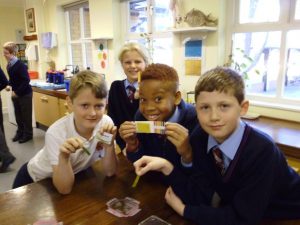 7th November 2016, pupils from Dean Close Preparatory School warmly welcomed Emma Wride from ESERO for a Science Space Day. Pupils aged nine and ten spent an entire day learning what’s involved in becoming an astronaut and exploring some of the experiments scientists use to test whether there has ever been or might be, life on Mars.
7th November 2016, pupils from Dean Close Preparatory School warmly welcomed Emma Wride from ESERO for a Science Space Day. Pupils aged nine and ten spent an entire day learning what’s involved in becoming an astronaut and exploring some of the experiments scientists use to test whether there has ever been or might be, life on Mars.
‘Mission X’ was the morning’s challenge. The children were fascinated to learn how astronauts prepare to go into space, such as, spending time in an enormous tank of water in special suits to experience working in a microgravity environment. They also learned about the ‘vomit comet’, this is a modified KC135 four engine jet set to fly on a parabolic orbit so that for a certain period of time, it is falling freely towards Earth. In this period, astronauts practise eating, drinking and using various kinds of on- board shuttle equipment. Pupils also learnt how important it is for astronauts to be fit and healthy and how this is tested using urine samples – food colouring made a good substitute on the day.
The afternoon’s session was entitled ‘Is there anybody out there?’ Pupils split into teams to experiment on soil from ‘Mars’ to determine whether life might have existed or currently does exist there. They tried techniques such as filtration and tested the acidity or alkalinity of the soil using Litmus paper. They also had a go at creating their own craters and making their own ‘exploding’ volcanoes.
Pupil, Evie Cooper said, “Fantastic, brilliant day! I loved all the experiments, making craters was so much fun. I am going to go home and try recreating the volcano at home using vinegar and bicarbonate of soda.”
Mr Fraine, Head of Science explained, “Earlier this year Dean Close Prep took part in the Tim Peake rocket seed experiment. Schools across the country were invited to grow two batches of seeds, one that had been sent to space with Tim and other seeds that had remained on Earth. As a result of our participation ESERO contacted us, asking if pupils would like the opportunity to learn, in detail, more about life as an astronaut and ‘life’ on Mars – we were of course delighted. In the same week the results came in from the Royal Horticultural Society, notifying us that the seeds on Earth grew slightly better than the space seeds. It was a really exciting way to conclude what has been a fantastic project.”